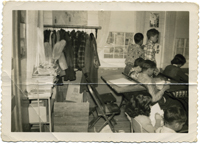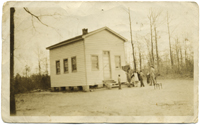Keeping
Their Heritage Alive
Story by
Audrey Hingley, Contributing Writer
|

The
school as it stands today.
|
For
Virginia�s Upper Mattaponi Tribe, the Sharon Indian
School stands as a monument to the perseverance of a people.
The
nondescript brick building with gleaming white windows sits adjacent to
Indian View Baptist Church on Route 30, a winding two-lane road filled with
pastoral vistas that links nearby Aylett to West Point in King William
County east of Richmond.
A
roadside historical marker and a painted sign identify the building as
Sharon Indian School, but it�s likely that most who drive this road are
unaware of the significance behind the only remaining public Indian school
building in Virginia.
That�s because Sharon School, an
education center for the Upper Mattaponi Tribe since 1919, is not just a
historic site: It�s a physical reminder of a not-too-distant Virginia past
where America�s original people endured not only segregation, but a
struggle for education and their own identity.
That struggle was magnified by the
effects of Virginia�s Racial Integrity Act of 1924, a strict
race-classification law defining everyone by only two categories:
�white� or �colored.� Dr. Walter Plecker, who was registrar of
Virginia�s Bureau of Vital Statistics from 1912-�46, promoted and
embraced the law, which not only prohibited marriage between whites and
non-whites, but changed racial labels on vital records. On paper, Virginia
Indians were erased from legal existence as generations of ethnic identity
were altered on public documents. Some term the law�s legacy �paper
genocide� of Virginia Indians. While native people nationwide share unique
challenges, the state law remained in effect until a 1968 U.S. Supreme Court
declared it unconstitutional.
�He
[Plecker] did force people to document themselves as something other than
what they were. It was sanctioned by the state,� explains Ken Adams, 61,
chief of the Upper Mattaponi Tribe.
Assistant Chief Frank Adams, 55,
explains, �Our parents protected us from knowing the laws on the book.
When my mother passed away a few years ago, I became the keeper of her
papers and reading some of it brought a tear to my eye. My grandparents had
to go around to large white landowners in King William and get them to sign
a paper verifying they were Indian. It had to be very humbling.�
In Virginia for Centuries
Ancestors of the Upper Mattaponi have
lived near Virginia waterways for centuries. When the British arrived in
1607, native Virginia Indians were prospering under Chief Powhatan, who led
more than 30 different tribes. As tribes were displaced, by the 1700s
Mattaponi who remained upriver had adopted the surname Adams, possibly due
to an area British interpreter named James Adams. Known as the Adamstown
Band, the tribe officially changed its name to the Upper Matta�poni
Indian Tribe in the early 20th century.
A non-reservation tribe, the Upper Matta�poni
own 32 acres of tribal land. The original Sharon School, like many rural
schools of its era, was a one-room frame structure with no indoor plumbing,
heated by a pot-belly wood stove. It was built in 1919 by members of the
Adams�town Band on tribal
land. In 1952 the current architect-designed brick school was erected by
King Wil�liam
County. For several years, the two buildings overlapped in use. The late
Helen Hill taught at the school from 1925-1930 and 1946-1964.
�I have fond memories of Mrs. Hill,�
says Ken Adams. �She was very stern but I seem to remember her as fair.
Lunch was in the old 1919 building and two people prepared our meals.�
�I got married at age 19 and Mrs. Hill
came to my wedding ... she made an impression on us,� recalls Connie
Lovelace, 52. �I remember each row in the school was a grade, maybe two or
three kids in each row.�
When he started at Sharon, Frank Adams
was the only first-grade student in his row. �Mrs.
Hill moved me to second grade after the first six weeks. I graduated from
high school when I was 16 years old,� he explains.
Virginia provided a seventh-grade
education until 1952, when they offered Sharon School students an 11th-grade
option. To earn a high school diploma, students had to relocate to complete
their education, and families had to be separated.
�Beginning in the 1940s, the Upper
Mattaponi Tribe tried to obtain methods of getting a high school education
for the kids. The pastor of Indian View church had gone to Michigan and
found some folks [there] who kids could board with,� Ken Adams explains.
�And I remember going to the train station and dropping off my older
brother, who had to go to an Indian [boarding] school in Oklahoma [to
complete high school].�
He adds that Indian View Baptist Church,
built in 1942, is �the glue that held the tribe together,� noting that
Virginia Indians in general have a strong Christian faith.
|
 
The
school as it appeared in 1925. |
Adams went to Sharon for 10 years,
moving to a sister�s house in Richmond to attend 11th grade at Thomas
Jefferson High School.
�It was a big shock,� he says of the
transition. �I didn�t know what a homeroom was. I had a [class] schedule
and was looking for a room with a 300 number ... I wandered around for
awhile because I didn�t realize it was on the third floor.�
With desegregation, Sharon School closed
in 1964 and the Upper Mattaponi went to county schools. Ken Adams spent his
senior year at King William High School, becoming one of the school�s
first two Indian graduates in 1965. The Upper Mattaponi who were the first
Indians to attend the formerly all-white school still find it difficult to
discuss that time.
�It
was obvious there was some resentment ... it�s hard to explain what that
year was like,� Ken Adams says. �There were incidents that occurred that
were pretty bad. You can explain discrimination in terms of things like not
getting a job, but you can�t explain personal [emotional] aspects of
it.�
Connie Lovelace recalls, �The kids
asked a lot of questions. They asked if I was a papoose ... I think they saw
us as they saw Indians hundreds of years ago. They wanted to touch my
hair.�
Frank Adams, educated at Sharon for six
years, started grade seven at King William�s campus. �I got an F on my
report card, the first one I ever got. I had been a straight-A student. My
mom talked to the teacher, and after that I did okay,� he remembers. �I
was a good-sized fellow so I didn�t get hassled too much. I played sports,
ran track and made several close friends. But kids are mean ... I remember
running around the track and hearing them yell, �Run, Indian, run.� I
heard the little �woo-woo Indian in the house� [comments].�
|

Today,
the Sharon Indian School building is used by the Upper Mattaponi for
tribal meetings. Pictured here are former Sharon School students
Carol Howell, Connie Lovelace, Joanie Faulkner, Ben Adams, Frank
Adams, Ken Adams, and Roland Adams. |
After Sharon School closed in 1965, the
county used it for offices. The building was returned to the Upper Mattaponi
in 1987 and is on the Virginia Landmarks Register and The National Register
of Historic Buildings. Today it functions as a tribal center and is
undergoing renovation. The footprint of the 1919 school, which was torn down
by the county, is easily located; one archaeologist noted its
�archaeological ability to yield information important in history ... it
did not experience major disturbance as its successor was located adjacent
to, but not directly upon, its remains.�
Ironically, Virginia�s segregation
policies helped in one way: According to Chief Adams, Indian schools �were
profound in helping us retain our specific identity.�
He adds, �You don�t grow as a person
with everything being good in your life ... the difficulty was that in order
to get a decent education, family members had to be separated.�
The Commonwealth of Virginia formally
recognizes eight tribes, including the Upper Mattaponi, whose ancestors can
be traced directly to groups living in Virginia in 1607. Treaties and other
legal actions, including the establishment of reservations, pre-date the
U.S. Constitution. Virginia has maintained relationships with its tribes for
over 400 years, and yet these tribes have never been recognized by the
federal government. Over 500 tribes across the U.S. have recognition, but
not one is from Virginia. Federal recognition offers acknowledgment as well
as eligibility for federal grants and other help in areas like education and
health care.
The Virginia Indian Tribal Alliance for
Life (VITAL) says tribes have been slighted in the process of federal
recognition due in part to Dr. Plecker�s campaign of racial
classification. Typically, tribes must apply with the federal Bureau of
Indian Affairs and meet a list of strict standards, including proving
continuous existence for at least 100 years. Virginia�s Racial Integrity
Act resulted in continuity gaps in records, making it nearly impossible for
Virginia Indians to prove their existence.
Rep. James Moran (D-8th) first
introduced a federal recognition bill for Virginia tribes in 1999. The
current bill�s predecessor was passed by the House in 2007, but the Senate
later let it die in committee. Virginia chiefs journeyed again to Washington
in March 2009 to make their case and Ken Adams is hopeful that federal
recognition is on the horizon.
There were about 15,000 Native Americans
in the Tidewater area in the early 1600s. Today only about 4,000 Indians
remain in Virginia, including 575 Upper Mattaponi. Ken Adams went on to earn
a degree from Southern Illinois University, spent 24 years in the U.S. Air
Force and worked as an airplane maintenance instructor. Connie Lovelace is a
registered nurse and Frank Adams is owner of Glenwood Golf Club, Inc., in
Richmond.
�I�d
like people to know the Upper Mattaponi are good, decent people who have
become successful in mainstream America, but we�re also trying to keep our
heritage alive,� Frank Adams says.
�My
parents never went past the second grade, but we [I and my three siblings]
all graduated in the top 10 percent of our class,� Lovelace notes. �We
are survivors and we still exist.�
Chief Ken Adams emphasizes, �My
observation is that only in the last 20 or 30 years have Indians in general
come out of a period that was really heartbreaking. I�d like people to
know there�s still a strong, vibrant Indian community in Virginia.
�We haven�t lost our identity as
Indian people.�